23 March 1430 - 25 August 1482
Margaret of Anjou was born on the 23rd of March 1429 at Pont-à-Mousson in the Duchy of Lorraine. She was the daughter of René, Duke of Anjou and Isabella, Duchess of Lorraine. Her father, René, of the House of Valois-Anjou, was Duke of Anjou and titular King of Naples, Sicily and Jerusalem and her mother was the Duchess of Lorraine in her own right.
Margaret of Anjou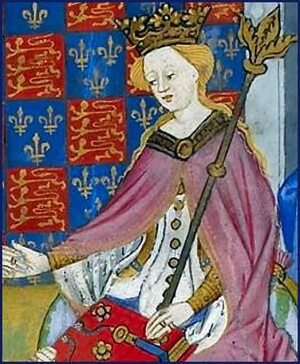
Margaret spent her early years living in the castle of Tarascon in the Rhone Valley and at the palace at Capua in Naples, educated by her mother and Antoine de la Salle. She was betrothed to King Henry VI of England by her uncle Charles VII of France, as part of a peace treaty between the two countries. The terms of the marriage were that she would not provide a dowry and instead would receive the lands of Maine and Anjou from the English. The couple were married on 23rd April 1445 when Margaret was fifteen years old, her new husband was eight years older.
Henry VI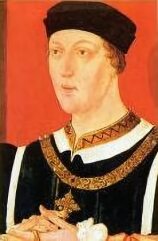
The marriage proved to be an unpopular one. In 1453, at the age of 32, Henry VI began to exhibit signs of serious mental illness. By means of a "sudden fright", he entered into a trance-like state reacting to and recognising no one. Catatonic schizophrenia or depressive stupor have been suggested as a likely diagnosis. This was probably an inheritance from his grandfather, Charles VI of France, who suffered from bouts of schizophrenia. Margaret at the time seven months pregnant attempted to claim the regency but gained no support. It was given instead to Henry's cousin, Richard, Duke of York, much to the annoyance of the Queen, who strongly felt that she and her party should govern England. An intense personal rivalry developed between Richard Duke of York and Margaret's favourite, Edmund Beaufort, Duke of Somerset. Richard Plantagenet, Duke of York, stood very near to the throne, his mother, Anne Mortimer, was by the strict rules of primogeniture the true heir of Richard II and York was her only son.
Margaret gave birth to her only child, Edward, Prince of Wales in October 1453 at Westminster Palace. Rumours abounded, fed by the Yorkists, that the child was not the feeble-minded king's but Somerset's, all of which threw more fuel on the fires of discontent. The Queen, "a strong laboured woman", was fiercely protective of her son and his rights. Henry eventually recovered his senses and when showed his son, declared himself pleased and enquired about the child's godfathers. Adding to existing doubts about the child's paternity, he declared that Edward must have been fathered by the Holy Ghost. York, dismissed from office, was discontented. His position, he realised, was now a precarious one, exposed as he was to the suspicion and venom of the Queen, who once again controlled the government.
Signature of Margaret of Anjou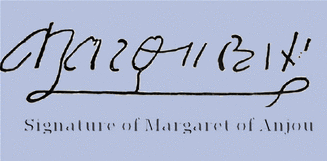
A great council was called at Leicester. York and his allies, Richard, Earl of Warwick and his father, Richard Neville, Earl of Salisbury, suspecting unimpartial treatment, travelled south with an army. Attempts at discussion between the factions evoked further anger on both sides. The First Battle of St. Albans was fought on 22nd May 1455. Margaret's favourite, Edmund Beaufort, Duke of Somerset was killed and Henry captured by the victorious Yorkists. York was appointed Protector of England. Margaret, true to character, was not going to accept this meekly. She gathered an army to advance her son's cause and York, Salisbury and Warwick were forced into flight before her.
The rebel lords gathered support and in retaliation took London. Warwick met the forces loyal to the king at Northampton, defeated them, and took the unfortunate Henry captive back to London. York returned from exile and laid formal claim to the throne. When asked why he had not previously done so, he responded that "though right for a time lies silent, yet it rotteth not, nor shall it perish." A compromise was agreed on, whereupon Henry VI was to keep the throne for the rest of his lifetime but the succession was to go to York and his heirs. No one for a moment expected that the spirited Margaret would accept the disinheriting of her son and this proved to be the case.
Queen Margaret led a Lancastrian army to attack the Duke of York at his castle at Sandal at Wakefield. The Duke was killed leading an impulsive charge against the Lancastrian forces, as was Salisbury and York's second son, the seventeen-year-old Edmund, Earl of Rutland, whose pleas for his life were ignored. The Queen had their heads impaled on spikes on the city walls of York.
A large Lancastrian army proceeded towards London, which defeated Warwick at the Second Battle of St. Albans. Warwick marched west to join forces with the approaching Yorkist army under Edward, Earl of March, York's able eldest son, leaving London undefended. The citizens of London refused to open the gates to the Lancastrians forcing them to withdraw north to Yorkshire. Edward, Earl of March, aged eighteen and now leader of the Yorkist cause, retaliated and defeated the Lancastrians at Mortimers Cross. He continued to utterly crush the Lancastrian cause at the decisive and bloody Battle of Towton in Yorkshire. Margaret and her son took flight to Scotland where they found refuge and the new Duke of York was crowned at Westminster as King Edward IV. King Henry VI was eventually taken prisoner in Lancashire and imprisoned in the Tower of London.
Edward Prince of Wales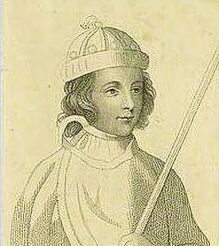
Margaret lived in exile in France with her son Edward. The mighty Richard Neville Earl of Warwick, discontented that he had not been given the power he had assumed by his support of the Yorkist cause, was alienated from Edward IV by the latter's marriage to Elizabeth Woodville, whom he heartily disliked. Supported by George, Duke of Clarence, Edward's equally disaffected brother, Warwick led a rebellion against Edward. In a subtle stroke of diplomacy, Louis XI of France, known as the Spider, reconciled the discontented Warwick with Margaret, no mean feat, since they were bitter enemies and Margaret had executed Warwick's father, Salisbury. Warwick is reported to have spent hours on his knees before Margaret before she would consent to the alliance. His younger daughter, Anne Neville, was betrothed to Margaret's son, Edward.
Warwick invaded England on Margaret's behalf in 1470, resulting in the flight of Edward IV to Burgundy and the release of Henry VI from the Tower of London and his brief reinstatement as king. A sad and pitiful figure, he was paraded through the streets of London in a shabby blue gown by George Neville, Archbishop of York and set up as a puppet King, whom the ambitious Warwick ruled through. Edward IV, backed by the Duke of Burgundy, returned in 1471, meeting Warwick's forces at Barnet. Having no longer anything to gain from the outcome of the battle, George, Duke of Clarence, Shakespeare's 'quicksand of deceit' was reconciled with his brother Edward, deserted his father-in-law and took his considerable forces into the ranks of the Yorkists.
A thick mist descended before the battle, obscuring sight of the enemy, resulting in both army's being incorrectly aligned, with their wings overlapping. The royal army duly advanced, the right-wing outflanking Warwick's left. The same situation arose with the royal left wing, which was similarly outflanked and routed by Warwick's right, commanded by the Earl of Oxford, an excellent general. The King managed to deploy his reserve and attacked Warwick in the centre. Oxford, who had been engaged in the pursuit of the fleeing Yorkists, returned to the battle, due to the thick mist, Montague's men mistook Oxford's banner for the Yorkist sun in splendour and opened fire on them. Oxford's contingent fled and the rebels were routed. Warwick's brother, John, Marquis Montague, was killed in the course of the battle and according to the official version of the battle, the mighty Warwick himself was killed fleeing the field in an attempt to reach his horse. Probably the most likely method of his despatch was a sword thrust into his throat, after forcing open his visor.
Memorial plaque to Edward Prince of Wales, Tewkesbury Abbey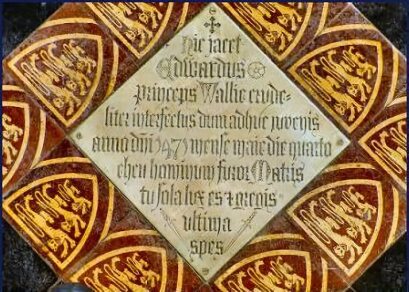
A wound on the left side of his neck is depicted in an illustration in the Yorkist chronicle the Arrival. Edward IV's sister Margaret Duchess of Burgundy, who must have been well informed, in the course of writing to her mother-in-law a few days after the battle, states that the Earl of Warwick was captured at the end of the battle, and whilst in the course of being taken alive to Edward "some men recognised him and killed him". Warwick's body together with that of his brother, Montague, were later displayed at St. Paul's covered only with a loincloth, before being buried at Bisham Priory in Berkshire.
Margaret and her son sailed for England on 24th March. Storms forced her ships back to France several times, but she finally landed at Weymouth in Dorset on the same day that the Battle of Barnet was fought. On hearing news of the disaster at Barnet, she considered returning to France, but Prince Edward persuaded her to gamble for victory and she led her army northwards in the hope of joining forces with Lancastrian supporters in Wales, led by Jasper Tudor, Henry VI's half-brother.
Intercepted by Edward IV, she had no choice but to meet him in battle at Tewkesbury on 4th May 1471. Margaret took refuge in a religious house some distance from the battlefield, her son, Edward, Prince of Wales, was killed either in battle or during its aftermath. There are several versions concerning how Edward met his end, one states he was cut down as he fled north in the aftermath of the Battle of Tewkesbury, another states that following the rout of the Lancastrians at Tewkesbury, a small contingent of men under the Duke of Clarence found Edward near a grove, where he was immediately beheaded on a makeshift block, despite pleas for mercy to his brother-in-law Clarence. An alternative version was given by three other sources: The Great Chronicle of London, Polydore Vergil and Edward Hall, which was the version used by Shakespeare. This records, that Edward, having survived the battle and was taken captive and brought before Edward IV who was with George, Duke of Clarence; Richard, Duke of Gloucester; and William, Lord Hastings. The king received the prince graciously and asked why he had taken up arms against him. The prince replied defiantly, "I came to recover my father's heritage." The king then struck the prince across his face with his gauntlet hand and those present with the king then suddenly stabbed Prince Edward with their swords.
Memorial plaque to Henry VI, Tower of London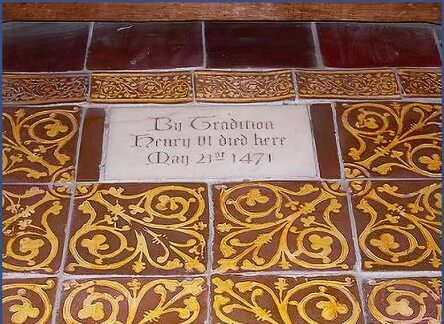
Queen Margaret was defeated at last by the death of the son she had fought so long and hard for. She was taken captive by William Stanley at the end of the battle and imprisoned. Sent first to Wallingford Castle, Margaret was later transferred to the more secure Tower of London; in 1472 she was placed in the custody of her former lady-in-waiting Alice Chaucer, Duchess of Suffolk. Her beloved son's widow, Anne Neville, later married Richard, Duke of Gloucester, Edward IV's youngest brother.
Henry VI met his death in the Tower of London, on the night of the Vigil of the Ascension, 21st -22nd May 1471. The demise of his son at Tewkesbury had sealed his fate. While Edward of Lancaster still lived, he had rendered the removal of Henry pointless.
Due to controversy over the manner of his death, George V gave permission to exhume the body of King Henry VI in 1910. The skeleton was found to have been dismembered before being placed in the box and not all the bones were present. Three very worn teeth were found and the only piece of jaw present had lost its teeth before death. The bones were recorded as being those of a strong man measuring five feet nine to five feet ten inches tall. Light brown hair found matted with blood on the skull confirmed that Henry VI had died as a result of violence.
Margaret's ageing but ebullient father, Rene of Anjou, remained unconcerned about his daughter's fate, having recently remarried, he was preoccupied with his new young wife. She remained a prisoner until she was ransomed by her kinsman, Louis XI, at the Treaty of Picquigny in 1475.
The embittered ex-Queen retired to her native Anjou, dependent for a pension on Louis, who made her surrender in return for her claims to her father's inheritance. She took up residence at the Chateau of Dampierre, she died there in August, 1482, aged fifty-three. She was buried in Angers Cathedral.
The Ancestry of Margaret of Anjou
Margaret of Anjou
Paternal Grandfather: Louis II of Anjou
Paternal Great-grandfather: Louis I of Anjou
Paternal Great-grandmother: Marie of Blois
Paternal Grandmother: Yolande of Aragon
Paternal Great-grandfather: John I of Aragon
Paternal Great-grandmother: Yolande of Bar
Mother: Isabella, Duchess of Lorraine
Maternal Grandfather: Charles II, Duke of Lorraine
Maternal Great-grandfather: John I, Duke of Lorraine
Maternal Great-grandmother: Sophie of Württemberg
Maternal Grandmother: Margaret of the Palatinate
Maternal Great-grandfather: Rupert of Germany
Maternal Great-grandmother: Elisabeth of Nuremberg
Edmund Beaufort PreviousNext Edward of Lancaster
